Photos: Kip Miller
"So you've just arrived from Umbria! How lucky for you!" comments the friendly concierge at Rome's Ambasciatori Palace. "Umbria is the 'old' Italia, where people can live really well and there is much less pressure." He looks up at us with a tinge of nostalgia: "I haven't been up there in years!"
It's the
end of our two-week tour of central Italy and we are back in Rome for
the first time since 1969. But I am jumping way ahead of myself. My husband
and I and our friends Kathy and Eric are taking a tour that began in Florence,
the domain of the Medici family, where breathtaking palaces, art treasures
and churches attract millions of tourists each year. Tuscany's capital
was followed by a leisurely exploration of its rolling countryside and
hill towns, an adventure I will share at another time. Truth be told,
we were especially eager to discover adjoining Umbria, "the Italophile's
Italy," a slow-paced, food lover's destination where locals roll
up their sleeves and tend their farms and vineyards.
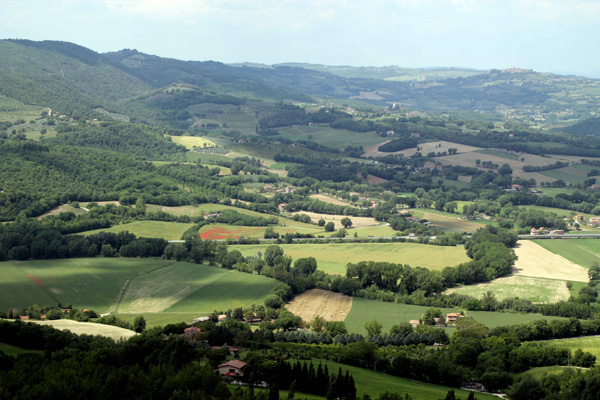
Umbria is the step-sister of Tuscany, a landlocked region famed for aromatic olives and ruby Sagrantino grapes. It is the epicenter of Italy's "Slow Food" movement.
It is a week earlier. Our tour group is being shepherded by Lisa, a vivacious
English woman who has lived in Italy for many years, is fluent in Italian
and steeped in its history and customs. She is one of the most thoughtful
and detail-oriented guides we have ever encountered, "OK, sweeties,"
Lisa begins with an endearment she repeats frequently. "Let me introduce
you to Umbria, the famous green heart of Italy known as 'il cuore verde.'
It's a unique region, the only one that does not touch a sea or another
country." Umbria, the stepsister of Tuscany, is brand new to all
of us. I immediately envision burnt umber, a paint color synonymous with
dark earth, but the dense green landscape belies its name.
I scrutinize the terrain out of my bus window as we begin to approach to Lago Trasimeno, Italy's fourth largest lake situated at the foot of the Lower Apennine Mountains. "A great battle took place here about 2,200 years ago," says Lisa. "It was during the Second Punic War, when Rome and Carthage were fierce enemies. Hannibal pulled a surprise attack on the Roman troupes that were led by the impetuous Consul Gaius Flaminius. He came ahead of the Romans with 40,000 men and realized it was a perfect place for an ambush with the lake to the left and the hills to the right. He lit fires to make believe his soldiers were encamped while they hid in the trees. The Romans arrived and were trapped. It was a tremendous massacre, the greatest ambush in military history. More than 30,000 soldiers died and the lake turned red with blood." Apparently, Hannibal achieved his rout in part by cutting off the Roman supply line, a military coup that is still studied today. "It took three days for the lake to clear and a small stream that feeds it was renamed Sanguineto (bloody)!" Lisa snickers.
The lake is soon eclipsed by the lush Umbrian countryside, steeper and more wooded than Tuscany's and famed for its aromatic olives, dark ruby Sagrantino wines and versatile Grechetto whites. We zip past Perugia, capital of Umbria and a lively university town. "It was once the crown of the Etruscan Empire," says Lisa. "Today Perugia is famous for exquisite chocolate confections. I wish I had samples for you to taste." My husband suddenly recalls some news clips of recent years: "Wasn't Perguia the university that Amanda Knox attended? It was here that Meredith Kircher was murdered and Knox was imprisoned for four years before her acquittal!"
The aroma of damp, fecund earth drifts through an open window in the bus. "Umbria is renowned for its medieval hill towns and traditions that haven't changed for centuries," says Lisa as we begin our approach to Assisi, one of Italy's great pilgrimage sites and ancestral home of St. Francis. Straight ahead of us a rolling valley is carpeted with wild asparagus and ginestra, a variety of scotch broom that is used in the making of actual brooms. "Many Umbrian farms are tended by mezzadri, sharecropper-like farmers who work the land for wealthy owners," she explains. "Here slow living is a way of life and earthy recipes make up a unique cuisine prepared in brick ovens. We call it 'cucina povera,' simple, peasant cooking." Just then we pass several roadside stalls lined with willow baskets full of wild porcini mushrooms. "By the way, no salt is used in making Umbrian bread," Lisa interjects. "This custom began in 1540 when the then current Pope imposed huge taxes on salt to pay for his papal states."
"St. Francis is the patron saint of Italy and of animals and the environment," Lisa announces as we head toward Assisi where the immense fortress of Rocca Maggiore crowns a network of 13th century walls. "The basilica, built at the edge of the cliff from 1228 to 1253, is a UNESCO World Heritage Site and, as you would expect, the town is always packed with tourists and pilgrims who come by the millions to worship." We are making our way through the Spoleto Valley which includes Mount Subasio Regional Park, a haven for nature lovers. Apparently when St. Francis was nearing his final hours on earth, he asked to be carried out to these hills. There, soothed by the chirping of his beloved birds, he met his maker. As we close in on Assisi I notice that it is bathed in a magical light, a haze that seems to drape the entire town in a gentle glow that adds to the religious mystique of the place.
Umbria is
famous for hundreds of other saints, including Benedict, Valentine and
Chiara, the latter an animal lover and a colleague of Francis's. We ascend
an escalator and continue on foot toward the Piazzetta of Santa Chiara.
Swarms of tourists are taking selfies in front of the surrounding hills.
"Welcome to Assisi," chirps Magdalena, a local guide who arrives
breathless at that very moment. "Let's start with a visit to the
church dedicated to Santa Chiara. She was a noble woman from the upper
town. Her parents wanted her to marry a wealthy man to consolidate the
family's position, but Chiara was already under the influence of Francis,
who was her friend," Magdalena explains. "She ran away from
home, renounced all worldly goods, cut off her hair and immersed herself
in a life of poverty and chastity, soon developing a devoted following
of women. They became the nucleus of a convent at San Damiano." Apparently,
humble Chiara was canonized shortly after her death in 1153. "Notice
the simplicity of this church," she adds as we enter. "The beautiful
rose window is exceptional, and when you go down to the crypt, you will
see her tomb." I glance at the nave's whitewashed walls, once adorned
with frescoes until a plague swept through Assisi and the church was sanitized.
The original painted Romanesque cross that spoke to Chiara at Damiano
hangs dramatically above the choir.
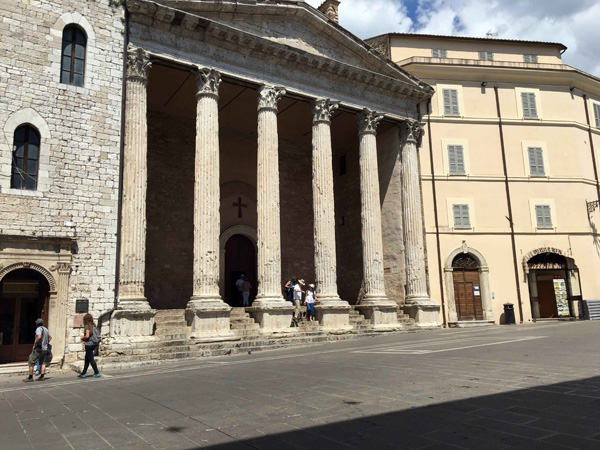
Delicately fluted Corinthian columns, part of an ancient temple to Minerva, serve as a church facade in Assisi's Piazza del Comune, the social hub of the city. The ancient Roman Forum is buried underneath.
"Assisi was once an important Roman town," Magdalena comments as we near the center. "At the Piazza del Comune, you will see one of the best preserved Roman temple facades in all of Italy." We pause by a row of delicately fluted Corinthian columns serving as a church facade. "The original Forum is hidden under the square," she says. The Comune functions as the social hub of Assisi with numerous cafes, shops and restaurants interspersed between the Palazzo del Capitano and the Gothic-styled former post office. The beautiful 18th century Fountain of Three Lions is a popular gathering spot for both locals and tourists. We trail behind Magdalena down Via San Francesco, descending steadily toward the basilica. Medieval buildings with shops on both sides house are crammed with religious souvenirs and kitsch memorabilia. Here and there pots of red geraniums and vines brighten their time-worn facades. Suddenly it comes into view, with swarms of clerics and international tourists in the foreground.
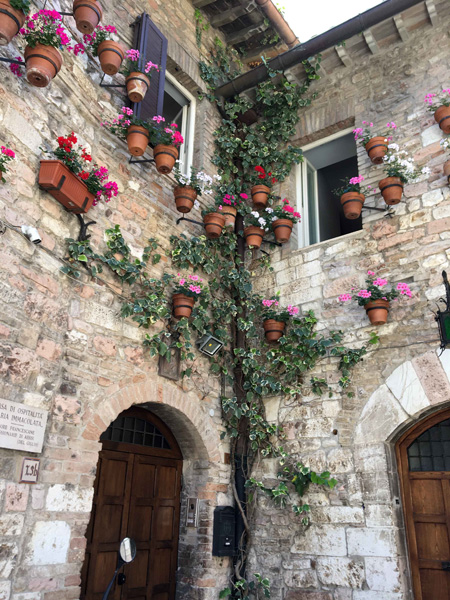
Assisi's time-worn medieval walls are brightened by pots of red geraniums.
"Where else can you find a church that's built on top of another church, with both still in use?" asks Eric, as we enter. Occupying the western end of Assisi, the basilica is perched dramatically over the valley below. The lower church houses Francis's crypt and is linked to the upper by a flight of stairs. "Francis lived a simple life of poverty, abstinence and renunciation of worldly goods as he searched for greater spirituality," says Magdalena, pointing an array of Byzantine-styled frescoes by an unknown artist adorning the austere nave. In 1818 his tomb was rediscovered and a new crypt was built around the original burial place. Amazingly, his skeleton was completely intact. "How often does that happen?" asks Kathy. In September 1997 a great earthquake struck the area and the basilica sustained major damage, including its priceless frescoes. "Fortunately, all have been restored and today we see them as they once were," Magdalena explains.
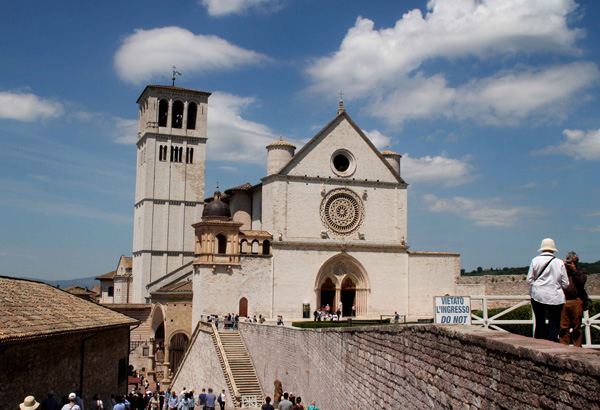
The upper church Assisi's Basilica of St. Francis houses one of Italy's greatest art troves -- 28 breathtaking frescoes by Giotto that introduced perspective, realism and emotion to medieval art.
The stairs to the upper church are extra steep, but we are assured the
climb is worth it. Here the main attractions are breathtaking frescoes
by Giotto that rank as one of Italy's greatest art troves. Twenty-eight
evocative scenes from St. Francis's life were quite revolutionary at the
time of their execution, introducing perspective and displaying an unprecedented
level of realism, with a depiction of emotion not seen before. I am especially
taken by a scene of Francis preaching to his beloved birds, and with another
where he tosses his fancy clothes to his father, trading luxury for total
poverty. The upper church is extremely crowded. Dozens of tour groups
are quickly shepherded from one fresco to another and I overhear a babble
of tongues as we make our way out the exit. "More than five million
tourists pass through the basilica each year," Magdalena boasts.
"Francis is considered a global symbol of peace."
It's all uphill to the fountain at Piazza del Comune where Lisa will be meeting us. We have worked up an appetite and stop midway, grabbing the last available sidewalk table at Antiche Sapori. The house Margherita and porcini mushroom pizzas are soul-satisfying accompanied by light beer. We continue toward our gathering spot, window shopping at a few galleries displaying hand-made linens and local crafts. One by one, our fellow travelers straggle in, each searching for a bench. Back on the bus, Lisa promises a surprise visit to a town that's not on the itinerary - Bevagna. "I think it is a special place and I hope you will agree," she says.
Completely
encased in walls, Bevagna was built by the Romans on a branch of the Via
Flaminia. It was a very popular outpost, famed for its expansive cattle
farms. "Even Nero's mother had a villa here," says Lisa. Today
its layers of history intertwine seamlessly, from the ambulatory of its
ancient Roman theatre to two remarkable Romanesque churches, San Silvestro
and San Michele Arcangelo, facing each other on a pristine medieval square.
"Bevagna is catching on with foodies," adds Lisa. "They
come to sample its exceptional white truffles and Montefalco Sagrantino
wines, and a chance to experience a lifestyle unchanged for centuries."
She leads us down winding stairs to the site of the theatre dating back
to the second century BC. Here, a vaulted ambulatory was once a passageway
of shops located beneath the seating. I am impressed by its excellent
state of preservation. An enthusiastic guide walks us past detailed sketches
of the facilities, ending in front of a jaw-dropping demo of an ancient
water wheel. "This is a time traveler's delight," my husband
chuckles as the apparatus cranks up. The ambulatory also doubles as an
upscale restaurant, Redibis, famed for lavish dinners and brunches. "Dining
here is a full immersion experience," brags the guide. We follow
her upstairs to a reconstructed museum-home where a colleague enumerates
the eccentricities of life in medieval times past. "Some people slept
in a sitting position in bed," he explains. "That way they could
get more air!"
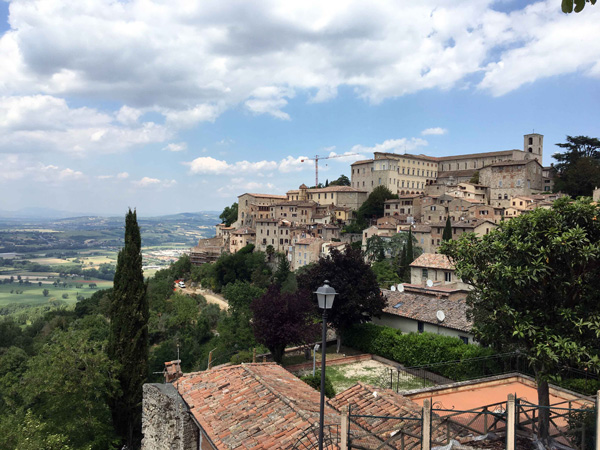
Intimate Todi, one of Umbria's iconic towns, is enclosed within three sets of walls: Etruscan, Roman and medieval.
Intimate Todi may be everyone's favorite Umbrian town, positioned on a
hilltop with sweeping vistas of the Tiber Valley. According to legend,
a group of families long ago were picnicking in the countryside when an
eagle swooped down and grabbed one of their tablecloths with his talons.
He soared high up in the sky, finally depositing it on a steep hill. It
was deemed a sign from heaven and the villagers decided to build a new
town on the site. Today Todi is still enclosed within three circles of
walls -- Etruscan, Roman and Medieval - with four entry gates. Its small
scale and slow pace enable visitors savor life's small pleasures. We arrive
in late afternoon, our bus granted special permission to bring us right
up to the Fonte Cesia, an old palazzo imaginatively transformed into a
four-star hotel and the only one within the walls. Nunzia Frustagatti,
the general manager greets us with a big smile: "You are going to
love Todi," she assures us. In traditional local style, the hotel
hosts us at a lavish dinner featuring stuffed zucchini blossoms and crostini,
house-made pasta, grilled meats and a bevy of regional pastries.
"Todi's
central square has appeared in many films," brags Francesca Tenti,
our local guide, as we gather in early morning at the intimate Piazza
del Popolo. "It is the very image of what people expect medieval
Italy to look like. Don't you agree?" The square is humming with
activity in preparation for "Todi Fiorina," its annual May flower
festival which attracts visitors from nearby towns. We make a bee line
to the Duomo at the far end, positioned atop flights of stairs. Built
over the site of a Roman temple and incorporating a few ancient columns,
it is an amalgamation of many styles, but the crypt is the only part of
the original building still fully intact. "The large rose window
was added in the 19th century," Francesca notes. "But please
don't miss the smaller windows designed by Perugino."
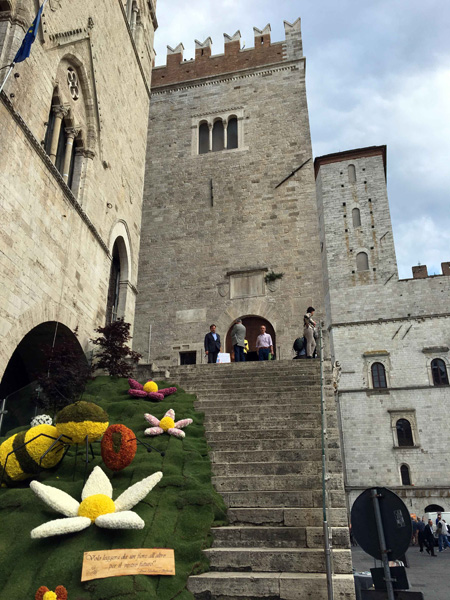
Todi's fascinating Civic Museum takes up the entire fourth floor of Palazzo del Capitano.
Even its staircase is dressed up for the flower festival.
At the opposite end of the piazza, Todi's fascinating Civic Museum takes up the entire fourth floor of the Palazzo del Capitano. "The original Etruscan walls that surrounded the town had no mortar," says Francesca as we enter. "When the town was conquered by the Romans in the 2nd century BC, it had 40,000 inhabitants. Today we have shrunk to 10,000." We stop to admire a scale model of the Renaissance church of Santa Maria della Consolazione in the shape of a Greek cross. "Many famous architects worked on it," Francesca boasts, "including Da Vinci. Notice the dome is topped by a cupola." I spot an old saddle on prominent display. "That's the saddle of Anita Garibaldi who was ailing and pregnant when she accompanied her husband to Todi after fleeing Rome," Francesa brags. Another jewel in the museum is "Mars of Todi," a hollow bronze statue of an Etruscan warrior discovered in 1865. "However, what you see here is a replica," she says. "The original is at the Vatican Museum because the inscriptions discovered on the breastplate enabled scholars to decode the Etruscan alphabet."

Mars of Todi," an ancient bronze statue of a warrior, was discovered near Todi in 1865.
Inscriptions on its breastplate helped scholars to decode the Etruscan alphabet.
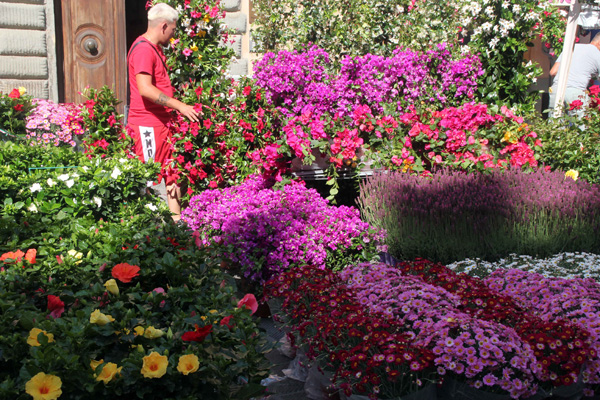
Todi's colorful May flower festival attracts thousands of visitors who come to shop, attend concerts and relax in its laid-back setting.
The four of us skip a visit to the Roman tunnels and cisterns located underneath the piazza in favor of the flower festival. The piazza is rapidly evolving into a spectacular scene: endless rose bushes, colorful ornamentals and annuals, displays of natural cosmetics, candies and sugared almonds artfully arranged into blossoms, hats and scarves fashioned from floral fabrics, and unusual glazed ceramics in vibrant hues. "If only we could take some of this home," sighs Kathy. We meander on Via Augusto Ciuffelli that descends to the town walls and stumble into Pane e Vino, a family-run restaurant recommended by Lisa. A table perched on the entry staircase allows us to catch the action in the street. The daughter brings out aromatic house bread flecked with sliced walnuts. It is delicious, unlike any bread we have ever tasted. She suggests we try the specials of the day: strangozzi with black truffles, tiny castelluccio lentils and artichoke salad. It is Umbrian cooking at its best. "I can see why this region is popular with foodies," says Kathy. "It would be wonderful to come here again and take some eco-tours of vineyards and farms!" I remark.
The Church of San Fortunato commands a prominent position on a knoll, its bell tower affording one of the best views in Todi. I spot a colorful shop nearby displaying Deruta pottery. We are searching for a sugar bowl and creamer set in the traditional Raffaellesco pattern, a design featuring the Umbrian fire-spitting dragon-serpent that has become a symbol of the region. Since Deruta is about 23 kilometers away and we will not have a chance to go there, we hope to get lucky in Todi. "I have been painting Deruta ceramics for more than 20 years," says Dr. Patrizio Agostinelli, proprietor of the shop. "Do you like my work? I teach special techniques for ceramics." He is holding a paint brush with a dollop of yellow paint over a bowl that features the stylized dragon, a mythical creature that supposedly inhabited a cave on one of Lake Trasimeno's islands. He was greatly feared by the region's inhabitants who attributed him with supernatural powers, both good and bad. Today the dragon is a symbol of luck, a talisman to ward off evil and a protector of sailors. He has been adorning glazed Deruta ceramics for over 500 years. We settle on two lovely bowls, but are unable to find a sugar bowl and creamer.

Dr Patrizio Agostinelli operates a shop in Todi specializing in Deruta majolica. Many of his pieces feature the Umbrian dragon-serpent that has been of a symbol of the region for centuries. The mythical creature is a beloved talisman and protector sailors.
On a downhill street from Piazza Garibaldi overlooking the Tiber Valley,
Miaoliche Pia is another local shop packed with colorful displays of Deruta
majolica. A placard claims that the company uses improved techniques and
paints to enhance traditional designs. I spot a Raffaellesco sugar bowl
in the size I want, but no creamer. "Let's wait and see if we can
find a set in Orvieto tomorrow," suggests my husband. A few hours
later, refreshed and dressed for dinner, we blend into a crowd of locals
taking their evening passiagetta, past fragrant flower stalls crowded
with young couples purchasing bouquets. On our must-try list is Le Scalette,
a popular restaurant in a medieval building with an airy terrace overlooking
the valley beyond. Timbered ceilings and walls hung with old utensils
and paintings add atmosphere. We peruse an extensive menu of traditional
specialties. Palomba alla ghiotta (spit-roasted wild pigeon seasoned with
herbs), a centuries-old preparation, is the house specialty. Eric opts
for a mixed grill that include wild boar, to be paired Sagrantino di Montefalco.
The rest of us select their house-made pasta tossed with wild asparagus
and herbs. We linger after dinner, watching the sun disappear behind the
hills, streaking the sky in orange and lavender.
Another of
Umbria's must-see towns is Orvieto, crowning a thousand-foot tufa outcropping
that rises above the valley below. The city was a major Etruscan stronghold,
and its mass of volcanic tufa is honeycombed with tunnels and cellars
where residents used to hide during sieges. It was conquered by the Romans,
later serving as a papal getaway during the Renaissance. As we get closer
to Orvieto, I can see a patchwork of pastel houses and palazzi clinging
to the hillsides. The valley floor below is a jumble of vines and spring
flowers. "Like Todi, Orvieto's fairytale location has been used in
several films," says Lisa. Straight ahead narrow back streets and
staircases coil serpent-like atop the pyramid hill. "Today Orvieto
is quite gentrified with many upscale shops and restaurants," she
adds. "It is famous throughout Italy for its magnificent Duomo and
a medieval atmosphere that has remained unchanged for centuries."
Orvieto is also a mecca for "slow food," a style of cooking
and a movement that has taken hold throughout Europe. "Unlike Americans,
Italians work 'to live,' with the emphasis on enjoyment," says Lisa.
"That sounds good to me," smiles Eric as we set out on the Corso
Cavour, past colorful food shops hung with boars' heads and balls of Pecorino
cheese. Several wine shops display prized local vintages. "Hold off
on food and wine," advises Lisa as we pass by. "We are going
to have an enormous lunch at a famous chef's farmhouse."
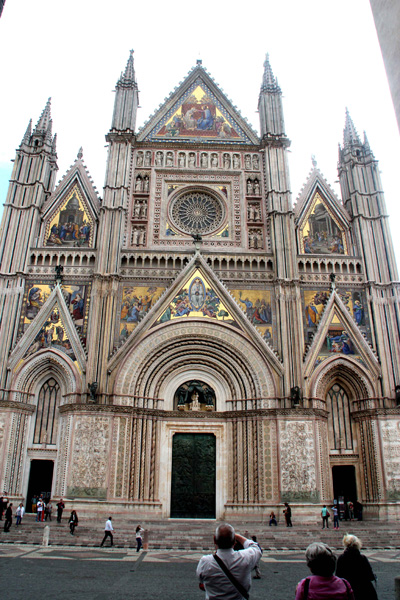
Orvieto's breathtaking Duomo seamlessly integrates glittering mosaics, delicate marble bas reliefs and magnificent bronze doors. Inside, vivid frescoes by Luca Signorelli were an inspiration to Michelangelo as he began to paint the Sistine Chapel.
Orvieto's magnificent Duomo rises high above its crenellated ramparts.
It began as a modest Romanesque church in 1290 and evolved into a full-blown
Gothic masterpiece over a period of three centuries. We are met by Manuela,
a genteel local guide who is also an accomplished art historian. "In
the Middle Ages Orvieto competed with many other city states," she
explains. "It was the era of grand cathedrals and the local people
just kept improving it. Thirty-three architects worked on the Duomo over
time. When it was finally finished, the townspeople dedicated it to Maria
della Stella -- Mary of the Stars." The facade manages to integrate
its diverse elements seamlessly, from glittering mosaics and delicate
marble bas reliefs highlighting important moments in the bible to massive
bronze doors depicting the four evangelists. "But above all, the
Duomo's showpiece is its San Brizio Chapel," asserts Manuela, as
she leads us through the understated interior to a space totally covered
with vivid frescoes. "The first two sections were completed by Fra
Angelico, the rest by Luca Signorelli." I am astounded by the latter's
fresco of "The End of Days," a hallucinatory scene of twisting
nude bodies and a terrifying depiction of the Antichrist that shocks even
today. "Signorelli's work was an inspiration to Michelangelo who
came to Orvieto often to study the frescoes as he embarked on The Last
Judgment for the Sistine Chapel," says Manuela as we depart.
Suddenly, a downpour emerges out of nowhere. We take refuge in a local café and listen attentively over steaming cappuccinos as Manuela reveals more about Orvieto. "This tufa mass is only a mile long and half a mile wide," she explains. "The city was easy to defend because of its high position and it remains traffic-free just as it was during the 12th century. Because it's Saturday, we will head straight to the Piazza del Popolo where a colorful market has been held for centuries." Lisa rushes out to purchase five-Euro umbrellas, but the rain vanishes as quickly as it appeared and we continue toward the market where local farmers, cheesemakers and butchers hawk food according to time-honored traditions. "It's a time warp, isn't it!" exclaims Manuela. We plunge into the crowd past a counter stacked with aromatic porchetta sandwiches and another with an array of soft and hard cheeses. One huge stall is heaped with fava beans, asparagus, fennel and assorted mushrooms and truffles. "I will leave you now to explore and shop on your own," says Manuela. "You have maps. Be sure to stroll on some of the tiny back streets. They haven't changed in centuries. Meet Lisa in one hour in front of the 12-sided tower of Sant'Andrea in the Piazza della Repubblica!"
"We're
heading toward Casa Segreta in the hamlet of Baschi, to Chef Lorenzo Polegri's
family farmhouse for a leisurely country lunch," Lisa announces as
our bus winds through well-tended olives groves and vineyards on the outskirts
of Orvieto. "He also owns Zeppelin, a popular restaurant and cooking
school on Via Garibaldi in Orvieto where many American culinary students
are trained. You are in for a real treat." Lorenzo and his significant
other, Kim Brookmire, an American from Boston, greet us warmly. Two long
tables in the large dining room are laid out bowls of farro salad plus
local cheeses, prosciutto and salumi accompanied by warm focaccia. Several
bottles of Orvieto Classico DOC are ready to pour. Just as we are about
to sit, I glance out the window at the surrounding fields. A rainbow has
appeared, an unmistakable good omen for our feast today.
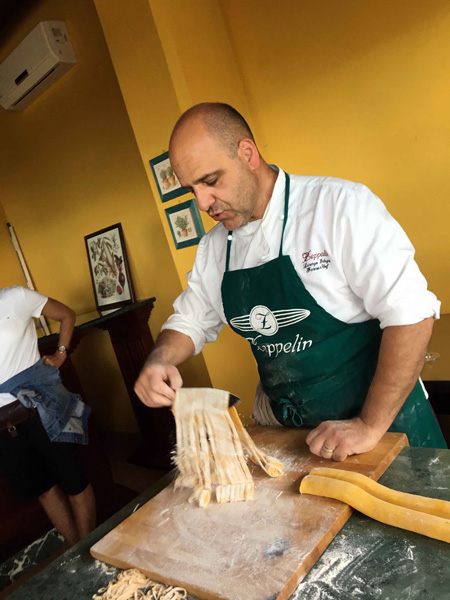
Chef Lorenzo Polegri deftly slices a mound of pasta at his family farm, Casa Segreta. Known as "The Etruscan Chef," he also operates Zeppelin, a popular restaurant and culinary school on Via Garibaldi in Orvieto.
"Let's begin our pasta demo," says Lorenzo, who has spent time in New York cooking at The James Beard Foundation. "We always use OO flour. It's very finely milled and easy to blend. Once the dough is mixed, you need to let it rest for two hours before working it. But this dough is ready to go." He rolls it out, turning and folding it repeatedly. "Now we are ready to slice the dough into strips. Who would like to come and try it out?" I am already up there taking photos so Lorenzo hands me a long knife. I do my best, but, like anything else, practice is required. Other volunteers come forward, trying their luck. Master Lorenzo takes over, deftly slicing the dough into different sizes of pasta. "Now it's time to eat," he smiles. Buon appetito!" Segreta's culinary students bring out serving bowls of steaming pasta tossed in an aromatic sauce, plus grilled chicken, local sausages and tiny skewers of marinated lamb. It is way more food than we could ever possibly eat. Huge dessert platters are next, laden with ricotta cassata tartlets, almond cake with Vin Santo custard, and mounds of fresh strawberries. Lorenzo arrives with an enormous pastry bag full of whipped cream to garnish the berries. "It has been a great pleasure to host you," he beams. "Grazie mille!" we respond. As we depart I purchase two copies of "The Etruscan Chef," the book he co-authored with Kim, anxious to learn more about this talented duo.
It is early evening in Todi when we return to the shop with the Raffaellesco sugar bowl, having had no luck in Orvieto. Kathy and Eric come to witness the transaction. "I don't believe it, the sugar bowl has been sold!" I complain. But tucked into a window display I had not previously noticed is the elusive matching creamer! We buy it, having learned our lesson, hoping to find a sugar bowl in Rome or elsewhere. There is time for a last stroll around town. Saturday's concerts have just let out and streets are teeming with people. Everyone is laughing and having a great time. Off the central piazza I spot Pianegiani, a bar-pastry shop famous for its artisanal gelato, reputedly the best in Umbria. We are not hungry, not even close, but each of us orders a single scoop of a favorite flavor. We grab an empty table, sit back and savor the moment. Two adorable little girls with curly locks are giggling non-stop as they lick their cones. Their doting grandmother is purchasing the last stash of chocolate biscotti behind the glass counter to take home. Outside, the evening breeze kicks up, wafting the scent of cinnamon from a nearby bakery. "How wonderful to be in Umbria!" I sigh with immense satisfaction.
